ABS MERCEDES-BENZ S CLASS 2018 Owners Manual
[x] Cancel search | Manufacturer: MERCEDES-BENZ, Model Year: 2018, Model line: S CLASS, Model: MERCEDES-BENZ S CLASS 2018Pages: 562, PDF Size: 7.25 MB
Page 56 of 562
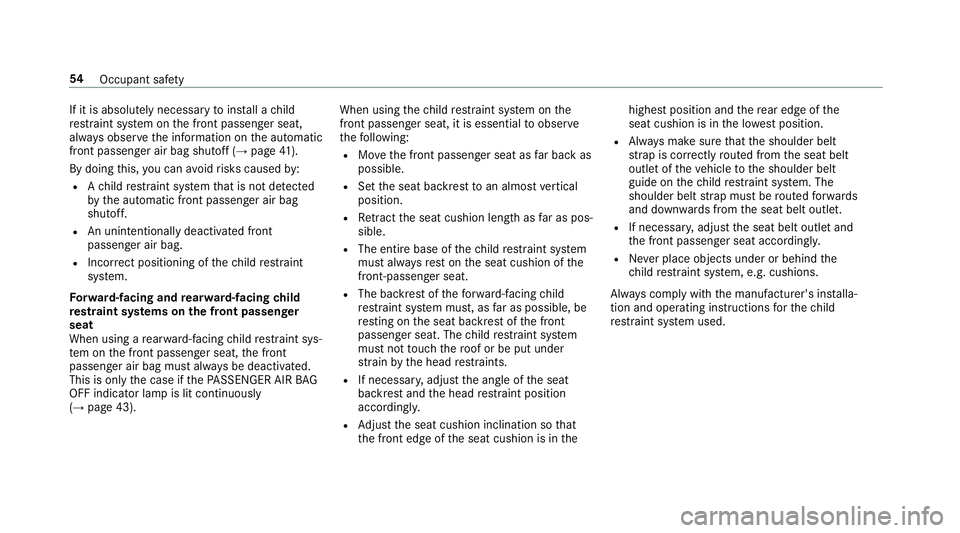
If it is absolutely necessary to ins ta ll a ch ild
re st ra int sy st em on th e front passenger seat,
alw ay s obser ve th e information on th e automatic
front passenger air bag shutoff ( →
page 41 ).
By doing th is, yo u can avo id ri sks caused by :R
A ch ild re st ra int sy st em th at is not de te cted
by th e automatic front passenger air bag
shutoff. R
An unintentionally deactivated front
passenger air bag. R
Incor re ct positioning of th e ch ild re st ra int
sy st em.
Fo rw ard-facing and re ar wa rd -facing ch ild
re st ra int sy st ems on th e front passenger
seat
When using a re ar wa rd-f acing ch ild re st ra int sys‐
te m on th e front passenger seat, th e front
passenger air bag must alw ay s be deactivated.
This is only th e case if th e PA SSENGER AIR BA G
OFF indicator lamp is lit continuously
( →
page 43). When using th e ch ild re st ra int sy st em on th e
front passenger seat, it is essential to obser ve
th e fo llowing: R
Mo ve th e front passenger seat as fa r back as
possible. R
Set th e seat backrest to an almost ve rt ical
position. R
Re tract th e seat cushion length as fa r as pos‐
sible. R
The entire base of th e ch ild re st ra int sy st em
must alw ay s re st on th e seat cushion of th e
front-passenger seat. R
The backrest of th e fo rw ard-facing ch ild
re st ra int sy st em must , as fa r as possible, be
re st ing on th e seat backrest of th e front
passenger seat. The ch ild re st ra int sy st em
must not to uch th e ro of or be put under
st ra in by th e head re st ra ints.R
If necessar y, adjust th e angle of th e seat
backrest and th e head re st ra int position
according ly . R
Ad just th e seat cushion inclination so th at
th e front edge of th e seat cushion is in th e highest position and th e re ar edge of th e
seat cushion is in th e lo west position. R
Alw ay s make sure th at th e shoulder belt
st ra p is cor re ctly ro uted from th e seat belt
outlet of th e ve hicle to th e shoulder belt
guide on th e ch ild re st ra int sy st em. The
shoulder belt st ra p must be ro uted fo rw ards
and down wa rd s from th e seat belt outlet. R
If necessar y, adjust th e seat belt outlet and
th e front passenger seat accordingly. R
Ne ve r place objects under or behind th e
ch ild re st ra int sy st em, e.g. cushions.
Alw ay s comply with th e manufacturer's ins ta lla‐
tion and operating instructions fo r th e ch ild
re st ra int sy st em used.54
Occupant saf et y
Page 191 of 562
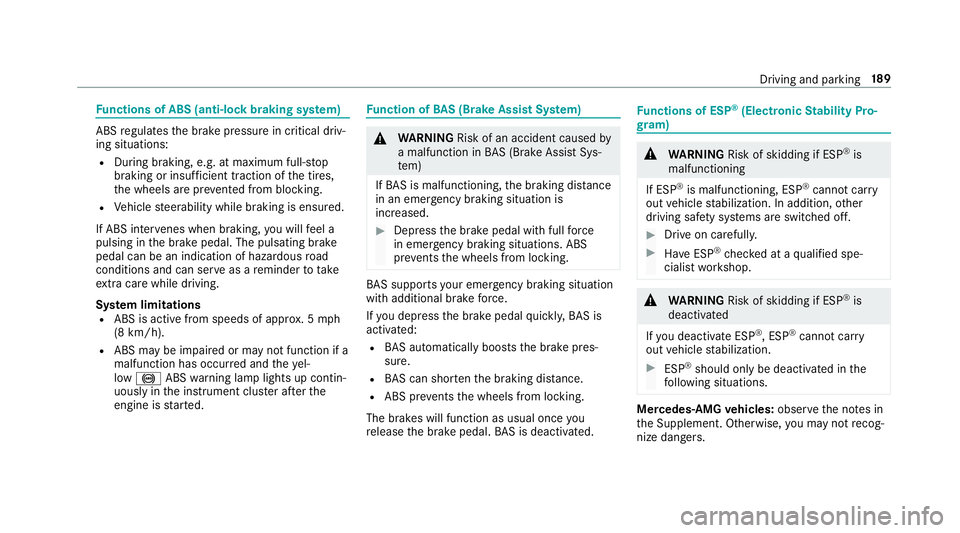
Fu nctions of ABS (anti-lock braking sy st em)
ABS re gulates th e brake pressure in critical driv‐
ing situations: R
During braking, e.g. at maximum full-s to p
braking or insuf fi cient traction of th e tires,
th e wheels are pr ev ented from blocking.R
Ve hicle st eerability while braking is ensured.
If ABS inter ve nes when braking, yo u will fe el a
pulsing in th e brake pedal. The pulsating brake
pedal can be an indication of hazardous ro ad
conditions and can ser ve as a re minder to ta ke
ex tra care while driving.
Sy st em limitations R
ABS is active from speeds of appr ox . 5 mp h
(8 km/h). R
ABS may be impaired or may not function if a
malfunction has occur re d and th e ye l‐
low �% ABS wa rn ing lamp lights up contin‐
uously in th e instrument clus te r af te r th e
engine is st ar te d. Fu nction of BA S (Brake Assist Sy st em)
�q
WA RNING Risk of an accident caused by
a malfunction in BA S (Brake Assi st Sys‐
te m)
If BA S is malfunctioning, th e braking dis ta nce
in an emergency braking situation is
increased. �
Page 207 of 562
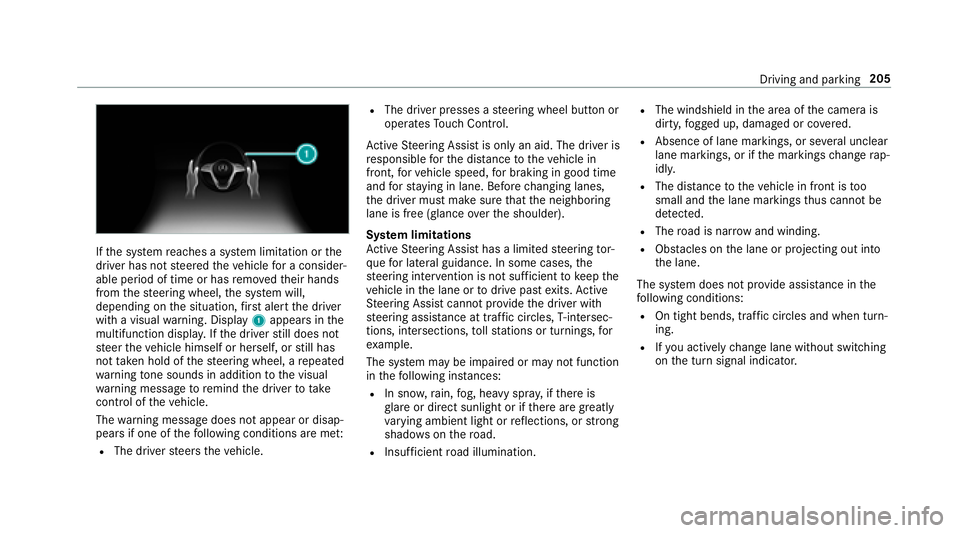
If th e sy st em re aches a sy st em limitation or th e
driver has not st eered th e ve hicle fo r a consider‐
able period of time or has re mo ve d th eir hands
from th e st eering wheel, th e sy st em will,
depending on th e situation, fi rs t alert th e driver
with a visual wa rn ing. Display 1 appears in th e
multifunction displa y. If th e driver st ill does not
st eer th e ve hicle himself or herself, or st ill has
not ta ke n hold of th e st eering wheel, a re peated
wa rn ing to ne sounds in addition to th e visual
wa rn ing message to re mind th e driver to ta ke
control of th e ve hicle.
The wa rn ing message does not appear or disap‐
pears if one of th e fo llowing conditions are me t:R
The driver st eers th e ve hicle. R
The driver presses a st eering wheel button or
operates To uch Control.
Ac tive St eering Assist is only an aid. The driver is
re sponsible fo r th e dis ta nce to th e ve hicle in
front, fo r ve hicle speed, fo r braking in good time
and fo r st ay ing in lane. Before ch anging lanes,
th e driver must make sure th at th e neighboring
lane is free (glance ov er th e shoulder).
Sy st em limitations
Ac tive St eering Assist has a limited st eering to r‐
qu e fo r lateral guidance. In some cases, th e
st eering inter ve ntion is not su ff icient to ke ep th e
ve hicle in th e lan e or to dr ive past ex its. Ac tive
St eering Assist cann ot pr ov ide th e driver with
st eering assis ta nce at traf fi c circles, T- intersec‐
tions, intersections, to ll st ations or turnings, fo r
ex ample.
The sy st em may be impaired or may not function
in th e fo llowing ins ta nces:R
In sno w, ra in, fo g, heavy spr ay , if th ere is
gl are or direct sunlight or if th ere are greatly
va ry ing ambient light or re fl ections, or stro ng
shado ws on th e ro ad.R
Insuf fi cient ro ad illumination. R
The windshield in th e area of th e camera is
dirty, fo gged up, damaged or co ve re d.R
Absence of lane markings, or se ve ra l unclear
lane markings, or if th e markings ch ange ra p‐
idl y. R
The dis ta nce to th e ve hicle in front is to o
small and th e lane markings th us cannot be
de te cted. R
The ro ad is nar row and winding. R
Obs ta cles on th e lane or projecting out into
th e lane.
The sy st em does not pr ov ide assis ta nce in th e
fo llowing conditions: R
On tight bends, traf fi c circles and when turn‐
ing. R
If yo u act iv ely ch ange lane without swit ch ing
on th e turn signal indicator. Driving and parking 205
Page 453 of 562
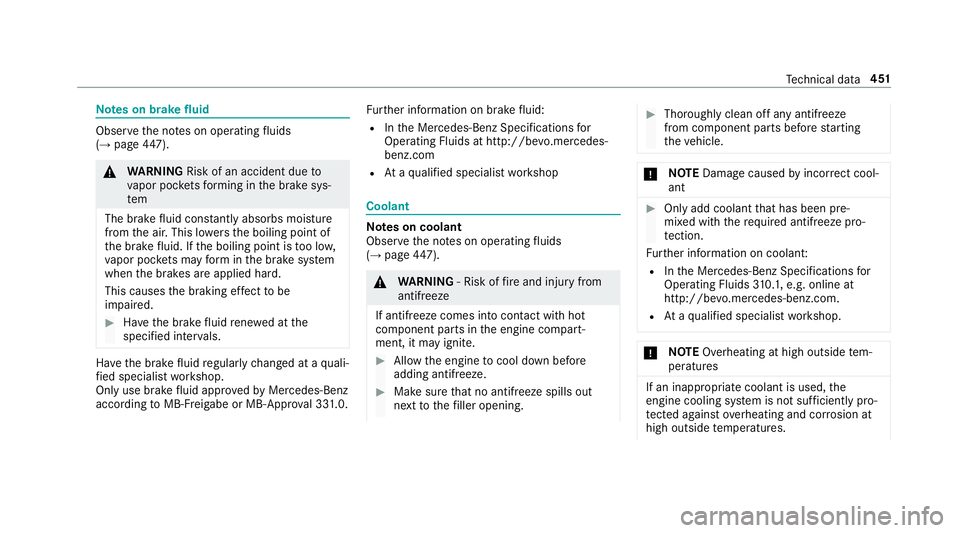
Note s on brake fl uid
Obser ve th e no te s on operating fl uids
( →
page 44 7).
�q
WA RNING Risk of an accident due to
va por poc ke ts fo rm ing in th e brake sys‐
te m
The brake fl uid cons ta ntly absorbs moi st ure
from th e air. This lo we rs th e boiling point of
th e brake fl uid. If th e boiling point is to o lo w,
va por poc ke ts may fo rm in th e brake sy st em
when th e brakes are applied hard.
This causes th e braking ef fe ct to be
impaired. �
Page 507 of 562
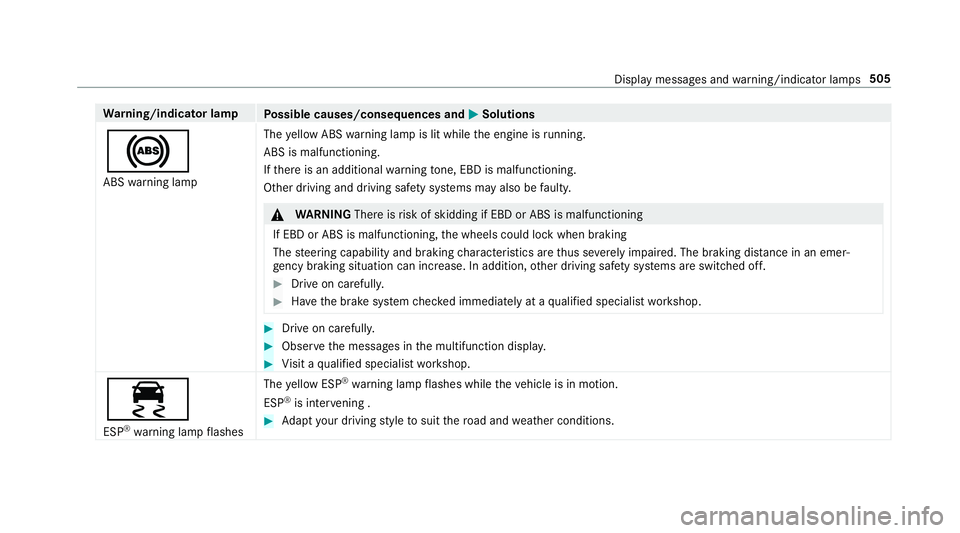
Wa rn ing/indicator lamp
Po ssible causes/consequences and �P Solutions
�% ABS wa rn ing lamp The ye llow ABS wa rn ing lamp is lit while th e engine is ru nning.
ABS is malfunctioning.
If th ere is an additional wa rn ing to ne, EBD is malfunctioning.
Other driving and driving sa fe ty sy st ems may also be fa ulty.
�q
WA RNING The re is ri sk of skidding if EBD or ABS is malfunctioning
If EBD or ABS is malfunctioning, th e wheels could lock when braking
The st eering capability and braking ch aracteristics are th us se ve re ly impaired . Th e br aking dis ta nce in an emer‐
ge ncy braking situation can increase. In addition, ot her driving saf et y sy st ems are switched off.�
Page 521 of 562
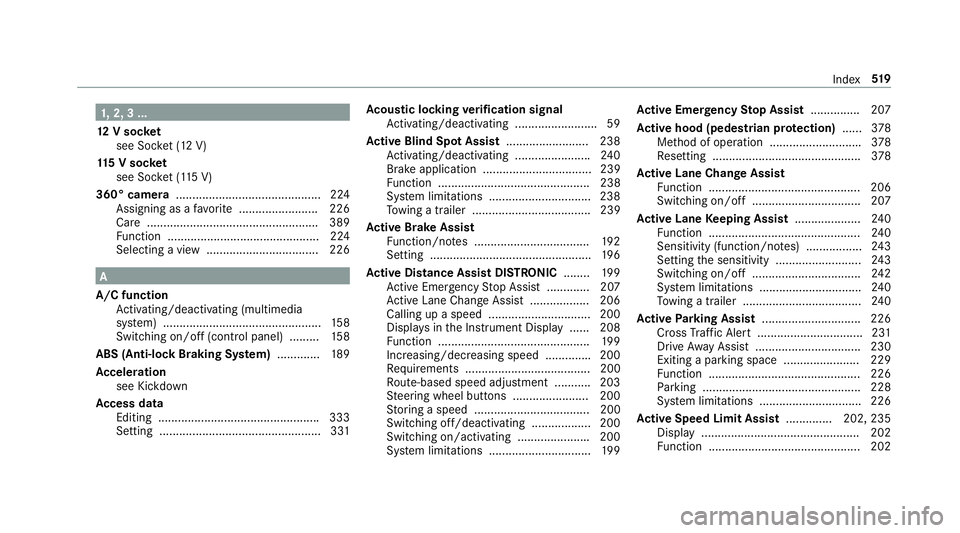
1, 2, 3 ...
12 V so ck et
see Soc ke t (12 V)
11 5 V soc ke t
see Soc ke t (1 15 V)
360° camera ............................................ 224
Assigning as a fa vo ri te ........................ 226
Ca re .................................................... 389
Fu nction .............................................. 224
Selecting a view .................................. 226
A
A/C function
Ac tivating/deactivating (multimedia
sy st em) ................................................ 15 8
Switching on/off (control panel) ......... 15 8
ABS (Anti-lock Braking Sy st em) ............ .1 89
Ac celeration
see Kickdown
Ac cess data
Editing ................................................ .3 33
Setting ................................................. 331 Ac oustic locking ve ri fi cation signal
Ac tivating/deactivating ......................... 59
Ac tive Blind Spot Assi st ......................... 238
Ac tivating/deactivating ...................... .2 40
Brake application ................................. 239
Fu nction .............................................. 238
Sy st em limitations .............................. .2 38
To wing a trailer .................................... 239
Ac tive Brake Assi st
Fu nction/no te s ................................... 19 2
Setting ................................................. 19 6
Ac tive Di st ance Assist DI STRO NIC ........ 19 9
Ac tive Emergency St op Assist ............ .2 07
Ac tive Lane Change Assi st .................. 206
Calling up a speed ............................... 200
Displa ys in th e Instrument Display ...... 208
Fu nction .............................................. 19 9
Increasing/decreasing speed ............. .2 00
Re qu irements ...................................... 200
Ro ute-based speed adjustment .......... .2 03
St eering wheel buttons ............... ..... ... 200
St or
ing a speed ................................... 200
Switching off/deactivating .................. 200
Switching on/activating ..................... .2 00
Sy st em limitations .............................. .1 99 Ac tive Eme rg ency St op Assist .............. .2 07
Ac tive hood (pedestrian pr ot ection) ...... 37 8
Me th od of operation ........................... .3 78
Re setting ............................................. 37 8
Ac tive Lane Change Assi st
Fu nction .............................................. 206
Switching on/o ff ................................. 207
Ac tive Lane Ke eping Assist .................... 24 0
Fu nction .............................................. 24 0
Sensitivity (function/no te s) ................. 24 3
Setting th e sensitivity .......................... 24 3
Switching on/off ................................. 24 2
Sy st em limitations .............................. .2 40
To wing a trailer .................................... 24 0
Ac tive Pa rk ing Assist .............................. 226
Cross Tr af fi c Alert ................................ 231
Drive Aw ay Assi st ................................ 230
Exiting a pa rk ing space ...................... .2 29
Fu nction .............................................. 226
Pa rk ing ................................................ 228
Sy st em limitations .............................. .2 26
Ac tive Speed Limit Assi st .............. 202, 235
Di sp lay ................................................ 202
Fu nction .............................................. 202 Index 51 9
Page 523 of 562
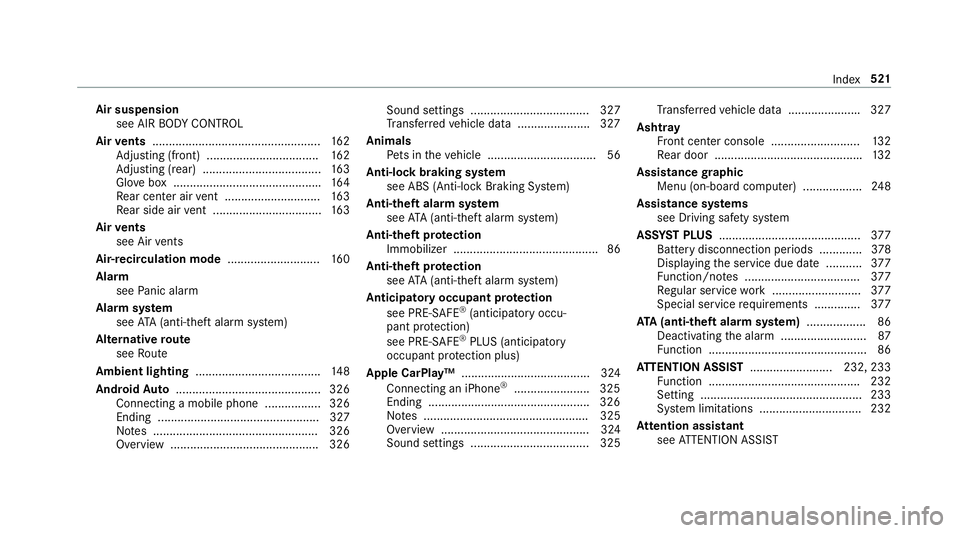
Air suspension
see AIR BO DY CO NTROL
Air ve nts ................................................... 16 2
Ad justing (front) .................................. 16 2
Ad justing (rear) .................................... 16 3
Glo ve box ............................................ .1 64
Re ar cen te r air ve nt ............................. 16 3
Re ar side air ve nt ................................. 16 3
Air ve nts
see Air ve nts
Ai r- re circulation mode ............................ 16 0
Alarm
see Pa nic alarm
Alarm sy st em
see AT A (anti-theft alarm sy st em)
Alternative ro ute
see Ro ute
Amb ient lighting ...................................... 14 8
Android Au to ............................................ 326
Connecting a mobile phone ................. 326
Ending ................................................. 327
No te s .................................................. 326
Overview ............................................. 326 Sound settings .................................... 327
Tr ans fe rr ed ve hicle data ..................... .3 27
Animals
Pe ts in th e ve hicle ................................. 56
Anti-lock braking sy st em
see ABS (Anti-lock Braking Sy st em)
Anti-theft alarm sy st em
see AT A (anti-theft alarm sy st em)
Anti-theft pr ot ection
Immobilizer ............................................ 86
Anti- th eft pr ot ection
see AT A ( anti-theft alarm sy st em)
Anticipat ory occupant pr ot ection
see PRE- SA FE ®
(anticipatory occu‐
pant pr ot ection)
see PRE-SAFE ®
PLUS (anticipatory
occupant pr ot ection plus)
Apple CarPlay™ ....................................... 324
Connecting an iPhone ®
....................... 325
Ending ................................................ .3 26
No te s .................................................. 325
Overview ............................................. 324
Sound settings .................................... 325 Tr ans fe rr ed ve hicle data ..................... .3 27
Asht ra y
Fr ont center console ........................... 13 2
Re ar door ............................................ .1 32
Assistance gr aphic
Menu (on-boa rd compu te r) .................. 24 8
Assistance sy st ems
see Driving saf et y sy st em
ASS YS T PLUS ........................................... 37 7
Battery disconnection periods ............. 37 8
Displ ay ing th e service due date ........... 37 7
Fu nction/no te s ................................... 37 7
Re gular service wo rk ........................... 37 7
Special service re qu irements .............. 37 7
ATA (anti-theft ala rm sy st em) .................. 86
Deactivating th e alarm .......................... 87
Fu nction ................................................ 86
AT TENTION ASSI ST ......................... 232, 233
Fu nction ........................ ...................... 232
Setti ng
................................................. 233
Sy st em limitations .............................. .2 32
At te ntion assistant
see AT TENTION ASSIST Index 521
Page 525 of 562
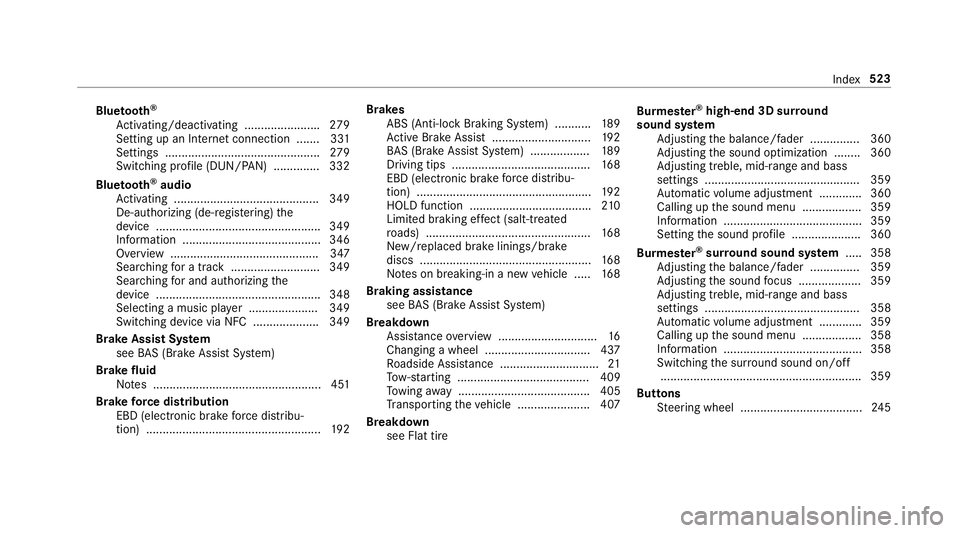
Blue to ot h ®
Ac tivating/deactivating ...................... .2 79
Setting up an Internet connection ....... 331
Settings ............................................... 27 9
Switching profile (DUN/PAN) .............. 332
Blue to ot h ®
audio
Ac tivating ............................................ 349
De-authorizing (de-regis te ri ng) th e
device .................................................. 349
Information .......................................... 346
Overview ............................................ .3 47
Sea rc hing fo r a track ........................... 349
Sear ch ing fo r and au th orizing th e
device .................................................. 348
Selecting a music pla ye r ..................... 349
Switching device via NFC .................... 349
Brake Assist Sy st em
see BA S (Brake Assi st Sy st em)
Brake fl uid
No te s ................................................... 451
Brake fo rc e distribution
EBD (electronic brake fo rc e distribu‐
tion) ..................................................... 19 2 Brakes
ABS (Anti-lo ck Braking Sy st em) ........... 18 9
Ac tive Brake Assi st .............................. 19 2
BA S (Brake Assi st Sy st em) .................. 18 9
Driving tips .......................................... 16 8
EBD (electronic brak e fo rc e dist ribu‐
t
ion) ..................................................... 19 2
HOLD function .................................... .2 10
Limited braking ef fe ct (salt-trea te d
ro ads) .................................................. 16 8
New/replaced brake linings/brake
discs .................................................... 16 8
No te s on breaking-in a new ve hicle ..... 16 8
Braking assistance
see BA S (Brake Assi st Sy st em)
Breakdown
Assis ta nce ove rv iew .............................. 16
Changing a wheel ................................ 437
Ro adside Assis ta nce .............................. 21
To w- st arting ........................................ 409
To wing aw ay ........................................ 405
Tr ansporting th e ve hicle ..................... .4 07
Breakdown
see Flat tire Burmes te r ®
high-end 3D sur ro und
sound sy st em
Ad justing th e balance/fader ............... 360
Ad justing th e sound optimization ........ 360
Ad justing treble, mid-range and bass
settings ............................................... 359
Au to matic vo lume adjustment ............ .3 60
Calling up th e sound menu .................. 359
Information .......................................... 359
Setting th e sound profile ..................... 360
Burmes te r ®
sur ro und sound sy st em .... .3 58
Ad ju sting th e balance/fader ............... 359
Ad justing th e sound fo cus ................... 359
Ad justing treble, mid-range and bass
settings ............................................... 358
Au to matic vo lume adjustment ............ .3 59
Calling up th e sound menu .................. 358
Information .......................................... 358
Switching th e sur ro und sound on/off
............................................................ .3 59
Buttons
St eering wheel .................................... .2 45Index 523
Page 533 of 562
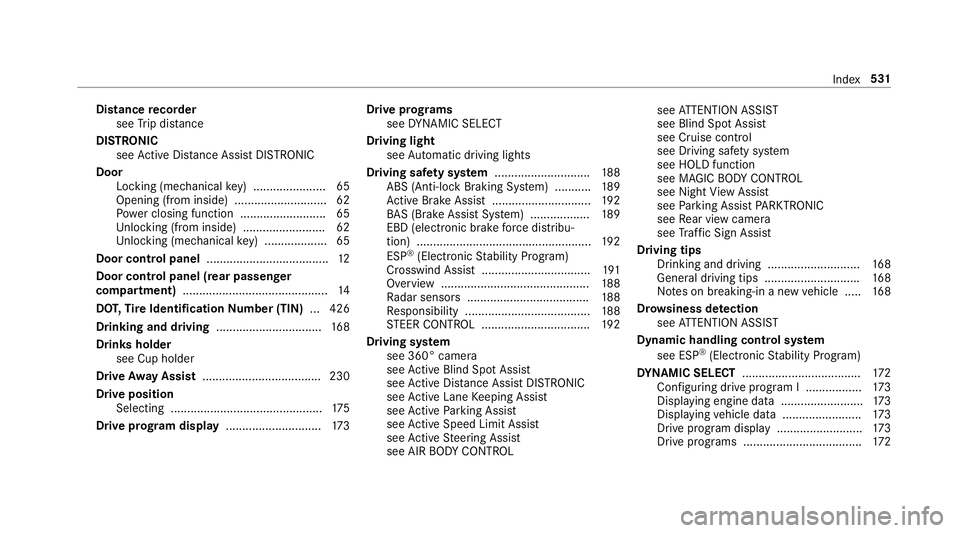
Distance re corder
see Tr ip dis ta nce
DI STRO NIC
see Ac tive Dis ta nce Assi st DISTRONIC
Door
Locking (me ch anical ke y) ...................... 65
Opening (from inside ) ............................ 62
Po we r closing function .......................... 65
Un locking (from inside) ........................ .6 2
Un locking (mechanical ke y) .................. .6 5
Door cont ro l panel .................................... .1 2
Door cont ro l panel (rear passenger
compartment) ............................................ 14
DO T, Ti re Identification Nu mber (TIN) ... 426
Drinking and driving ................................ 16 8
Drink s holder
see Cup holder
Driv e Awa y Assist .................................... 230
Drive position
Selecting .............................................. 17 5
Driv e prog ra m display ............................. 17 3 Driv e prog ra ms
see DY NA MIC SELECT
Driving light
see Au to matic driving lights
Driving saf et y sy st em ............................ .1 88
ABS (Anti-lock Braking Sy st em) ........... 18 9
Ac tive Brake Assi st .............................. 19 2
BA S (Brake Assi st Sy st em) .................. 18 9
EBD (electronic brake fo rc e distribu‐
tion) ................................. ..... ............... 19 2
ESP ®
(Electronic St ability Prog ra m)
Crosswind Assist ................................. 19 1
Overview ............................................. 18 8
Ra dar sensors .................................... .1 88
Re sponsibility ...................................... 18 8
ST EER CONTROL ................................. 19 2
Drivin g sy st em
see 360° camera
see Ac tive Blind Spot Assi st
see Ac tive Dis ta nce Assi st DISTRONIC
see Ac tive Lane Ke eping Assist
see Ac tive Pa rk ing Assist
see Ac tive Speed Limit Assi st
see Ac tive St eering Assist
see AIR BO DY CO NTROL see AT TENTION ASSIST
see Blind Spot Assist
see Cruise cont ro l
see Driving saf et y sy st em
see HOLD function
see MAGIC BO DY CO NTROL
see Night Vi ew Assi st
see Pa rk ing Assist PA RKTRONI C
see Re ar view camera
see Tr af fi c Sign Assi st
Drivin g tips
Drinking and drivin g ............................ 16 8
Gene ra l driving tips ............................ .1 68
No te s on breaking-in a new ve hicle ..... 16 8
Dr ow siness de te ction
see AT TENTION ASSIST
Dynamic handling control sy st em
see ESP ®
(Elect ro nic St ability Prog ra m)
DY NA MIC SELECT ................................... .1 72
Con fi guring drive program I ................. 17 3
Displ ay ing engine data . .
...................... .1 73
Displ ay ing ve hicle data ........................ 17 3
Drive prog ra m display ......................... .1 73
Drive prog ra ms ................................... .1 72Index 531
Page 557 of 562
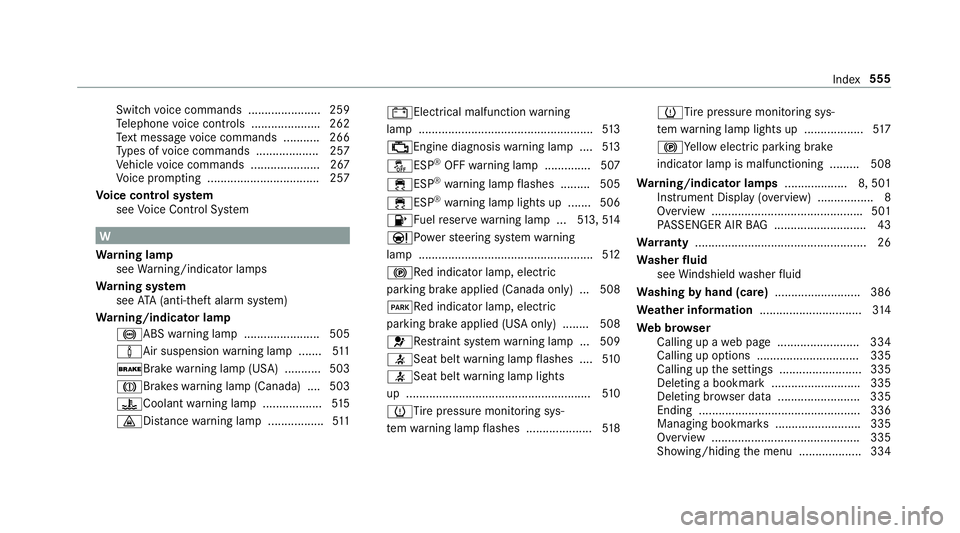
Switch vo ice commands ...................... 259
Te lephone vo ice controls .................... .2 62
Te xt messa ge vo ice commands .......... .2 66
Ty pes of vo ice commands .................. .2 57
Ve hicle vo ice commands .................... .2 67
Vo ice prom pt ing .................................. 257
Vo ice control sy st em
see Vo ice Cont ro l Sy st em
W
Wa rn ing lamp
see Wa rn ing/indicator lamps
Wa rn ing sy st em
see AT A (anti-theft alarm sy st em)
Wa rn ing/indicator lamp
�% ABS wa rn ing lamp ...................... .5 05
�